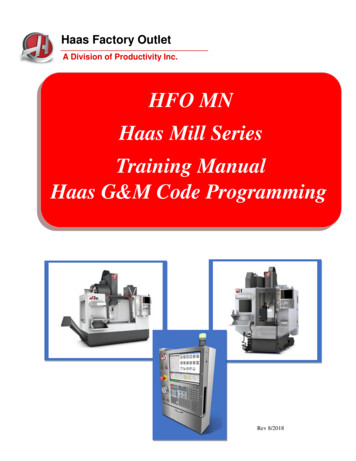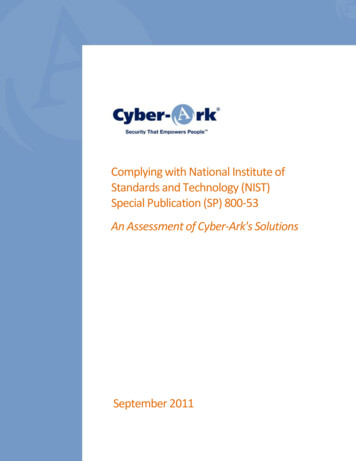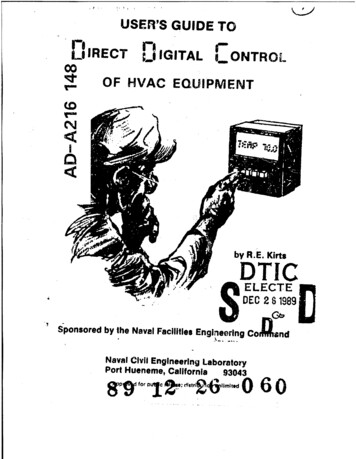
Transcription
Process Control Instrumentation Technology Johnson9 781292 0260158eISBN 978-1-29202-601-5Process Control InstrumentationTechnologyCurtis D. JohnsonEighth Edition
Process Control InstrumentationTechnologyCurtis D. JohnsonEighth Edition
Pearson Education LimitedEdinburgh GateHarlowEssex CM20 2JEEngland and Associated Companies throughout the worldVisit us on the World Wide Web at: www.pearsoned.co.uk Pearson Education Limited 2014All rights reserved. No part of this publication may be reproduced, stored in a retrieval system, or transmittedin any form or by any means, electronic, mechanical, photocopying, recording or otherwise, without either theprior written permission of the publisher or a licence permitting restricted copying in the United Kingdomissued by the Copyright Licensing Agency Ltd, Saffron House, 6–10 Kirby Street, London EC1N 8TS.All trademarks used herein are the property of their respective owners. The use of any trademarkin this text does not vest in the author or publisher any trademark ownership rights in suchtrademarks, nor does the use of such trademarks imply any affiliation with or endorsement of thisbook by such owners.ISBN 10: 1-292-02601-4ISBN 13: 978-1-292-02601-5British Library Cataloguing-in-Publication DataA catalogue record for this book is available from the British LibraryPrinted in the United States of America
PEARSONC US T OMLIBRAR YTable of Contents1. Introduction to Process ControlCurtis D. Johnson12. Analog Signal ConditioningCurtis D. Johnson553. Digital Signal ConditioningCurtis D. Johnson1234. Thermal SensorsCurtis D. Johnson1895. Mechanical SensorsCurtis D. Johnson2416. Optical SensorsCurtis D. Johnson3097. Final ControlCurtis D. Johnson3598. Discrete-State Process ControlCurtis D. Johnson4179. Controller PrinciplesCurtis D. Johnson47510. Analog ControllersCurtis D. Johnson51911. Computer-Based ControlCurtis D. Johnson55312. Control-Loop CharacteristicsCurtis D. Johnson605Appendix: UnitsCurtis D. Johnson647I
IIAppendix: P&ID SymbolsCurtis D. Johnson651Appendix: DerivationsCurtis D. Johnson658Appendix: Internet ResourcesCurtis D. Johnson665ReferencesCurtis D. Johnson669GlossaryCurtis D. Johnson670Index675
Introduction toProcess ControlINSTRUCTIONAL OBJECTIVESThis chapter presents an introduction to process-control concepts and the elements of aprocess-control system. After you read this chapter and work through the example problems and chapter problems you will be able to: 1Draw a block diagram of a simple process-control loop and identify each element.List three typical controlled variables and one controlling variable.Describe three criteria to evaluate the performance of a process-control loop.Explain the difference between analog and digital control systems.Define supervisory control.Explain the concept behind process-control networks.Define accuracy, hysteresis, and sensitivity.List the SI units for length, time, mass, and electric current.Recognize the common P&ID symbols.Draw a typical first-order time response curve.Determine the average and standard deviation of a set of data samples.INTRODUCTIONHuman progress from a primitive state to our present complex, technological world has beenmarked by learning new and improved methods to control the environment. Simply stated, theterm control means methods to force parameters in the environment to have specific values.This can be as simple as making the temperature in a room stay at 21 C or as complex as manufacturing an integrated circuit or guiding a spacecraft to Jupiter. In general, all the elementsnecessary to accomplish the control objective are described by the term control system.The purpose of this book is to examine the elements and methods of control system operation used in industry to control industrial processes (hence the term process control). ThisFrom Chapte5r 51 of Process Control Instrumentation Technology, Eighth Edition. Curtis D. Johnson. Copyright 2006by Pearson Education, Inc. Published by Pearson Prentice Hall. All rights reserved.1
INTRODUCTION TO PROCESS CONTROLchapter will present an overall view of process-control technology and its elements, includingimportant definitions.2CONTROL SYSTEMSThe basic strategy by which a control system operates is logical and natural. In fact, thesame strategy is employed in living organisms to maintain temperature, fluid flow rate, anda host of other biological functions. This is natural process control.The technology of artificial control was first developed using a human as an integralpart of the control action. When we learned how to use machines, electronics, and computers to replace the human function, the term automatic control came into use.2.1Process-Control PrinciplesIn process control, the basic objective is to regulate the value of some quantity. To regulatemeans to maintain that quantity at some desired value regardless of external influences. Thedesired value is called the reference value or setpoint.In this section, a specific system will be used to introduce terms and concepts employed to describe process control.The Process Figure 1 shows the process to be used for this discussion. Liquidis flowing into a tank at some rate, Qin, and out of the tank at some rate, Qout. The liquid inthe tank has some height or level, h. It is known that the output flow rate varies as the squareroot of the height, Qout K 2h, so the higher the level, the faster the liquid flows out. If theoutput flow rate is not exactly equal to the input flow rate, the level will drop, if Qout 7 Qin,or rise, if Qout 6 Qin.FIGURE 1The objective is to regulate the level of liquid in the tank, h, to the value H.2
INTRODUCTION TO PROCESS CONTROLTRThis process has a property called self-regulation. This means that for some input flowrate, the liquid height will rise until it reaches a height for which the output flow rate matchesthe input flow rate. A self-regulating system does not provide regulation of a variable to anyparticular reference value. In this example, the liquid level will adopt some value for whichinput and output flow rates are the same, and there it will stay. But if the input flow ratechanged, then the level would change also, so it is not regulated to a reference value.EXAMPLE1The tank in Figure 1 has a relationship between flow and level given by Qout K2hwhere h is in feet and K 1.156 (gal兾min)兾ft1兾2. Suppose the input flow rate is 2 gal/min.At what value of h will the level stabilize from self-regulation?SolutionThe level will stabilize from self-regulation when Qout Qin. Thus, we solve for h,h a22 gal兾minQout 2b ab 3 ft1兾2K1.156 (gal兾min)兾ftSuppose we want to maintain the level at some particular value, H, in Figure 1, regardless of the input flow rate. Then something more than self-regulation is needed.Human-Aided Control Figure 2 shows a modification of the tank system to allow artificial regulation of the level by a human. To regulate the level so that it maintains the valueH, it will be necessary to employ a sensor to measure the level. This has been provided via a“sight tube,” S, as shown in Figure 2. The actual liquid level or height is called the controlled variable.In addition, a valve has been added so that the output flow rate can be changed by thehuman. The output flow rate is called themanipulated variableor controlling variable.FIGURE 2A human can regulate the level using a sight tube, S, to compare the level, h, to theobjective, H, and adjust a valve to change the level.3
INTRODUCTION TO PROCESS CONTROLFIGURE 3An automatic level-control system replaces the human with a controller and uses a sensorto measure the level.Now the height can be regulated apart from the input flow rate using the followingstrategy: The human measures the height in the sight tube and compares the value to thesetpoint. If the measured value is larger, the human opens the valve a little to let the flowout increase, and thus the level lowers toward the setpoint. If the measured value is smallerthan the setpoint, the human closes the valve a little to decrease the flow out and allow thelevel to rise toward the setpoint.By a succession of incremental opening and closing of the valve, the human can bringthe level to the setpoint value, H, and maintain it there by continuous monitoring of the sighttube and adjustment of the valve. The height is regulated.Automatic ControlTo provide automatic control, the system is modified asshown in Figure 3 so that machines, electronics, or computers replace the operations of the human.An instrument called a sensor is added that is able to measure the value of the level and convert it into a proportional signal, s. This signal is provided as input to a machine, electronic circuit,or computer called the controller. The controller performs the function of the human in evaluating the measurement and providing an output signal, u, to change the valve setting via anactuator connected to the valve by a mechanical linkage.When automatic control is applied to systems like the one in Figure 3, which aredesigned to regulate the value of some variable to a setpoint, it is called process control.2.2 ServomechanismsAnother commonly used type of control system, which has a slightly different objectivefrom process control, is called a servomechanism. In this case, the objective is to force someparameter to vary in a specific manner. This may be called a tracking control system. In-4
INTRODUCTION TO PROCESS CONTROLFIGURE 4Servomechanism-type control systems are used to move a robot arm from point A topoint B in a controlled fashion.stead of regulating a variable value to a setpoint, the servomechanism forces the controlledvariable value to follow variation of the reference value.For example, in an industrial robot arm like the one shown in Figure 4, servomechanisms force the robot arm to follow a path from point A to point B. This is done by controlling the speed of motors driving the arm and the angles of the arm parts.The strategy for servomechanisms is similar to that for process-control systems, butthe dynamic differences between regulation and tracking result in differences in design andoperation of the control system. This book is directed toward process-control technology.2.3Discrete-State Control SystemsThis is a type of control system concerned with controlling a sequence of events rather thanregulation or variation of individual variables. For example, the manufacture of paint mightinvolve the regulation of many variables, such as mixing temperature, flow rate of liquidsinto mixing tanks, speed of mixing, and so on. Each of these might be expected to be regulated by process-control loops. But there is also a sequence of events that must occur inthe overall process of manufacturing the paint. This sequence is described in terms of eventsthat are timed to be started and stopped on a specified schedule. Referring to the paint example, the mixture needs to be heated with a regulated temperature for a certain length oftime and then perhaps pumped into a different tank and stirred for another period.The starting and stopping of events is a discrete-based system because the event is either true or false, (i.e., started or stopped, open or closed, on or off). This type of controlsystem can also be made automatic and is perfectly suited to computer-based controllers.5
INTRODUCTION TO PROCESS CONTROLThese discrete-state control systems are often implemented using specialized computerbased equipment called programmable logic controllers (PLCs).3PROCESS-CONTROL BLOCK DIAGRAMTo provide a practical, working description of process control, it is useful to describe theelements and operations involved in more generic terms. Such a description should be independent of a particular application (such as the example presented in the previous section) and thus be applicable to all control situations. A model may be constructed usingblocks to represent each distinctive element. The characteristics of control operation thenmay be developed from a consideration of the properties and interfacing of these elements.Numerous models have been employed in the history of process-control description; wewill use one that seems most appropriate for a description of modern and developing technology of process control.3.1Identification of ElementsThe elements of a process-control system are defined in terms of separate functional partsof the system. The following paragraphs define the basic elements of a process-control system and relate them to the example presented in Section 2.Process In the previous example, the flow of liquid in and out of the tank, the tankitself, and the liquid all constitute a process to be placed under control with respect to thefluid level. In general, a process can consist of a complex assembly of phenomena that relate to some manufacturing sequence. Many variables may be involved in such a process,and it may be desirable to control all these variables at the same time. There are singlevariable processes, in which only one variable is to be controlled, as well as multivariableprocesses, in which many variables, perhaps interrelated, may require regulation. Theprocess is often also called the plant.Measurement Clearly, to effect control of a variable in a process, we must haveinformation about the variable itself. Such information is found by measuring the variable.In general, a measurement refers to the conversion of the variable into some correspondinganalog of the variable, such as a pneumatic pressure, an electrical voltage or current, or adigitally encoded signal. A sensor is a device that performs the initial measurement and energy conversion of a variable into analogous digital, electrical, or pneumatic information.Further transformation or signal conditioning may be required to complete the measurement function. The result of the measurement is a representation of the variable value insome form requir
a host of other biological functions. This is natural process control. The technology of artificial control was first developed using a human as an integral part of the control action. When we learned how to use machines, electronics, and comput-ers to replace the human function, the term automatic control came into use. 2.1 Process-Control .


